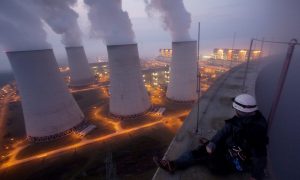How much carbon dioxide does China really emit? The question has long been a vexed one, particularly at climate talks, and is crucial because for almost a decade China has been ranked as the world’s largest emitter of the gas blamed mainly for climate change. That means the world’s largest energy consumer is under strong pressure to sign up to a global deal in Paris at the end of year that limits future growth in its CO2 emissions.
But China’s output of CO2 may have been substantially overestimated by international agencies for more than 10 years, mainly because researchers have factored in the wrong type of coal, says a new study by the UK’s University of East Anglia. In terms of climate change, this matters for several, crucial reasons.
Unless other countries have a clearer idea of what China actually emits – and the calculation for a country so vast and diverse has so far involved some degree of educated guesswork – China’s promises on peaking CO2 emissions by 2030 and any future cuts may be based on a flawed baseline.
And if the UEA’s measurements are taken at face value, in theory China could also argue that its output of CO2 is less high relative to other big emitters. This is important given the political pressure applied on China to sign up to potential emissions cuts beyond the end of the next decade.
However a recalculation of emissions to a lower baseline would imply that China could have a lower CO2 cap in the future if the country was ever to sign up to absolute targets.
More practically, the UEA research raises questions about how other large coal-dependent developing countries calculate their emissions, and whether international estimates for countries such as India and Indonesia are also wide of the mark.
The new research suggests China’s emissions from power generation and industry were around 2.49 billion tonnes of ‘carbon’ in 2013 – 300 million tonnes of carbon or 14% – lower than other estimates.
These include the Carbon Dioxide Information Analysis Centre (CDIAC) in the US and the Emissions Database for Global Atmospheric Research (EDGAR) in the EU, the official data sources for the International Panel on Climate Change’s Fifth Assessment Report.
The cumulative reassessment of Chinese emissions outlined in the study — roughly 2.9 billion tonnes of carbon from 2000 to 2013 — is larger than the estimated amount of carbon that the world’s forests sucked out of the atmosphere from 1990 to 2007.
One tonne of carbon is 3.67 tonnes of carbon dioxide equivalent (CO2e), the standard measure in estimates of greenhouse gas emissions, and UEA’s calculations suggest that the overestimate of China’s CO2 emissions in 2013, over 1 billion tonnes of CO2e, would be a good deal bigger than Germany’s entire greenhouse gas emissions for that year. China publishes data on energy statistics but not on its GHG emissions.
The UEA’s assessment is based mainly on new estimates of the types of coal burnt in China’s power stations and industrial plants, particularly those that make cement.
Previous calculations were based on Chinese data that lumped lots of different types of coal together, which international agencies then used in a formula known as a unified emission factor. This used a US/EU average in measurement of the carbon content of coal, resulting in an over-estimate of carbon emissions, says Professor Dabo Guan at the UEA, who was the lead author of the study.
But the emissions factors in low-grade Chinese coal may be 40% less than the calculations used by the IPCC and other agencies.
“China is the largest coal consumer in the world, but it burns much lower quality coal, such as brown coal, which has a lower heat value and carbon content compared to the coal burned in the US and Europe,” Guan points out in the report.
Estimates of Chinese emissions are highly uncertain due to conflicting assessments of energy consumption and emission factors, hugely important given that almost 75% of the global rise in global GHG emissions in 2010-2012 occurred in China, the UEA adds in the report.
The study also found that China’s energy consumption was 10% more than previously assumed over a 12-year period spanning 2000-2012, making a reassessment of the country’s true CO2 emissions even more stark.
Discrepancies
Li Shuo, an analyst at Greenpeace, and an expert on China’s CO2 emissions from coal, says the UEA study underlines the difficulty in securing reliable data for a country of China’s size and varying levels of fuel quality.
He adds: “It is important to strengthen China’s statistical capacity otherwise China’s climate commitments including its INDC (national climate plan) will only be castles in the air.”
Even though China recently undertook to measure its greenhouse gas emissions more effectively, the country wants to do so on its own terms. So far, China has rejected moves by the US and EU at UN climate talks to impose common accounting procedures, citing national sovereignty and differing responsibilities on tackling climate change.
Discrepancies between national and provincial figures continue to make it difficult to measure China’s emissions accurately, adds Prof Corinne Le Quéré, director of the Tyndall Centre for Climate Change Research at UEA. “There is still a lot of work to do,” says Le Quéré, who co-leads the publication of annual updates of emissions for the Global Carbon Project.
Big picture stays the same
The question also arises whether the claimed overestimate really matters that much, as it doesn’t change the fact that China remains by far the world’s biggest GHG emitter.
And national climate plans submitted by China and other large economies to the UN are far below what is needed to divert the world from runaway climate change, as pointed out by a study published Wednesday by the London School of Economics.
Its researchers said that based on the 50 or so national climate plans submitted so far, global GHG emissions would rise to as much as 59 billion tonnes of CO2e by 2030. This would be far beyond the 36 billion tonne figure that the UN estimates would be needed to give the world a fighting chance of limiting a global average temperature rise to 2C.
Global CO2 emissions from energy use are currently around 36 billion tonnes of CO2e, according to EDGAR data for 2013.
The full report can be found on Nature Magazine’s website here.






